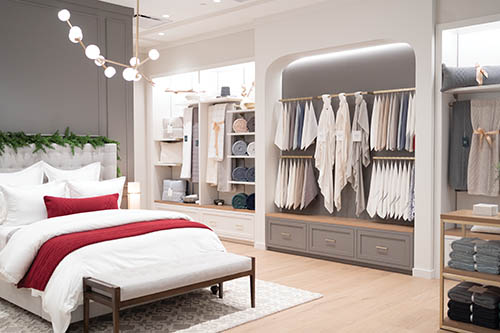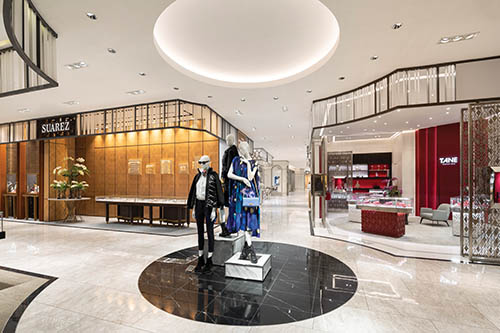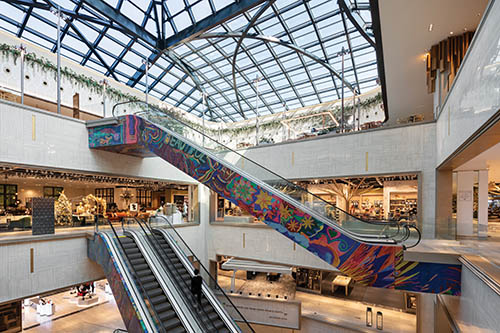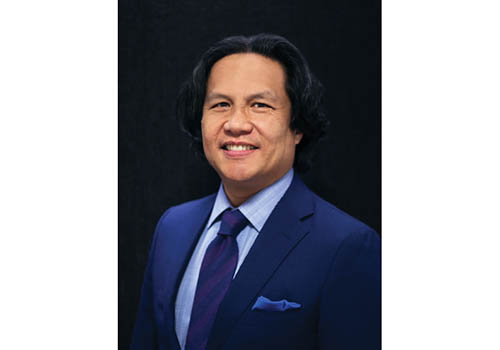— By Alec Zaballero —
Experiential design in brick-and-mortar retail offers competitive advantages.
Retail is on the rise. Despite continued discussion of rising inflation and a possible recession, U.S. gross domestic product grew by 2.1% year over year in 2022 vs. 2021, and the National Retail Federation economists expect it to continue growing into 2023.
E-commerce has grown exponentially in recent years, but brick-and-mortar stores still offer a substantial competitive advantage for retailers. Customers crave physical retail experiences after being locked to digital shopping for so long; 63% of customers 22 to 36 years old were willing to switch to in-store shopping if the experience was improved, according to research by Statistica.

The right retail design provides customers with a unique shopping experience that can strengthen a brand’s relationship with its customers and transform them from consumers into brand ambassadors. In order to compete in this constantly expanding and fiercely competitive market, businesses will need to improve the shopping experience for their customers by bringing their online brands “IRL” through innovative, in-person experiential retail design. Think of the shopping experience as online dating. When scrolling through profiles, you see who the person is first, their interests, where they work, etc., and then you decide if you want to “like” them or not. You only spend a few seconds making this decision, so your first impression is critical to secure a match and potentially the first date. If you blow the first impression, there is no second date! Designing for retail also adheres to this principle.
The first impression is crucial for enticing customers into the store and keeping them interested enough to shop, follow the brand online, and become brand ambassadors. The design should parallel the customer engagement model and leave a strong brand impression. Consistency, however, is the essential element for good retail design. Different brand impressions catch our attention and influence us at different moments and distances. A 40-foot-away object, a 20-foot-away object and a 5-foot-away object are all visible, but a seamless and successful shopping experience will only occur if these brand messages are consistent. For example, with our recent project for luxury home textiles retailer Boll & Branch, we carefully choreographed a journey of engagement that seduces, delights and enlightens those who visit. The design embraces the warmth and sophistication of a modern-traditional residence and brings the customer into the heart of their dream home.

A customer’s first impression of the brand starts from a distance, so we nestled exquisitely made beds in the window and in the center of the store to romance customers to step inside. These beds highlight the essence of Boll & Branch’s brand, unapologetically saying “this is us” to the customers from their first impression of the brand and the store. Once inside, we highlighted the products in refined residential settings under the glow of elegant chandeliers.
Although beautifully presented, new customers may not know the niche differences and details of luxury textiles. When shopping online, brands have blogs and articles so customers can research and learn more about the brand’s materials, fabrics and products without leaving the website. To bring this online experience in-person, we included information about the collections on accent tables and around the perimeter walls so customers can quickly learn. We also provided staff with a touch-down design studio space that enables them to assist customers in the collaborative design process, which is a crucial part of our overall customer engagement strategy.
A brick-and-mortar store’s location is also just as important for lifetime customer value as its internal design. Analyze the location data of a brand’s current online customer base to know where its most popular demographics are and build in those highly populated areas. These targeted locations will help deepen the bonds with current customers by validating the brand within the physical world. These locations will strengthen relationships with current customers who will now have firsthand experience of the brand, validating it and making them ambassadors. Companies that open a retail store in one of its target locations often see their online sales increase, creating a win-win opportunity.

Furthermore, each retail location’s design strategy will shift and adapt to the local region and culture. Our work for the luxury mall brand El Palacio de Hierro highly customizes each site to its locale; each store has a unique character with a holistic, interconnected design. For example, our most recent work for the Coyoacán location pays homage to Coyoacán as a cultural epicenter of Mexico City. The store celebrates the historic town’s creative legacy through a rich and immersive shopping experience with fresh mediums and innovative materials. Meanwhile, in the Perisur location, each department is showered in unique geometric patterns to metallic sculptural elements, which put a unique spin on mid-century modern design. The stores are a unified design theme while still holding to the El Palacio philosophy of providing different design concepts tailored to each department.
Brick-and-mortar stores are here to stay. According to analytical work by The Daily on Retail, a financially focused industry research platform, twice as many physical stores opened in 2021 than those that closed, and retail growth is expected to continue through 2023. To stay competitive in this new golden age of retail, it is crucial to create consistent and engaging brand impressions in physical retail stores to offer unique and impactful experiences for new customers and brand loyalists.
— Alec Zaballero, who has over 25 years of experience in the fields of architecture and interior environments, is managing executive of TPG Architecture. He spearheads the firm’s retail, hospitality and branded environments practice and has become known for his balance of design vision, management ability and technical skills, which he has brought to some of TPG’s most prestigious projects. He also has experience working on historic and landmark buildings.

